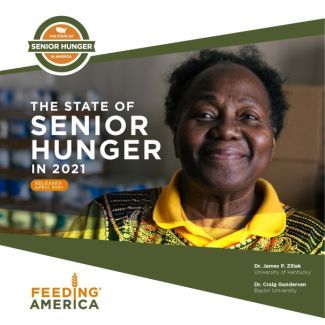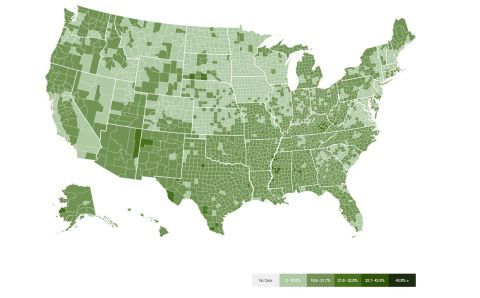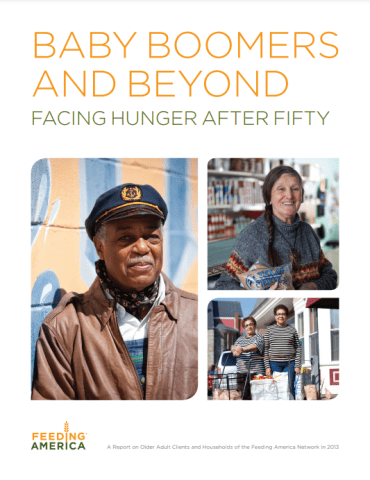Our research on food insecurity among seniors aims to identify the prevalence of senior hunger and to understand seniors' unique needs, characteristics, and risk factors. The research studies highlighted on this page inform our senior programs and efforts to eliminate senior hunger.
The State of Senior Hunger in America
In April 2023, Feeding America released The State of Senior Hunger in America in 2021. 2023 marks the seventh consecutive year that Feeding America produced The State of Senior Hunger in America report series which documents the prevalence of food insecurity among the senior population age 60 and older, as well as adults aged 50-59, at the national, state, and metro area. To produce the report series, Feeding America partnered with Dr. Craig Gundersen (Baylor University, Feeding America Technical Advisory Group (TAG) member and Principal Investigator of Map the Meal Gap) and Dr. James P. Ziliak (University of Kentucky).
The most recent report, The State of Senior Hunger in 2021, presents 2021 data from the Current Population Survey, the most recent year for which data are available. Findings reveal that 5.5 million seniors (7.1% or 1 in 14) were food insecure in 2021. The 2023 release also includes Hunger Among Adults Age 50-59 in 2021. Findings reveal that in 2021, 3.8 million adults aged 50-59 (9.4% or 1 in 11) were food insecure. As the senior population continues to grow, this analysis helps reveal the challenges faced today by millions of aging adults. It provides insight into the future challenges that the next generation of seniors may face.
Key Takeaways
1 in 14 seniors age 60 and older was food insecure in 2021. 7.1% of the senior population was food insecure.
The size of the senior population was 78 million in 2021, and 7.1%, or 5.5 million, experienced food insecurity. Neither the rate nor the number of food-insecure seniors was statistically significantly different than the prior year (6.8% and 5.2 million in 2020).
1 in 11 adults age 50 to 59, or 9.4% of the older adults population, were food insecure in 2021
There were approximately 41 million adults age 50-59 in the U.S. in 2021 and 9.4%, or 3.8 million, were food insecure. Both the rate and number of food-insecure older adults were statistically significantly lower than the prior year (10.4% and 4.3 million in 2020).
Food insecurity among both seniors and older adults remains higher than prior to the Great Recession
In a year when food insecurity declined to the lowest rates for individuals overall and children since the USDA began producing food security statistics, food insecurity among seniors did not change statistically significantly between 2020 and 2021. While food insecurity among seniors remains lower compared to younger people, food insecurity levels among seniors have not recovered to the same extent and remain higher than pre-Great Recession levels (6.3% in 2007).
Among older adults, food insecurity in 2021 decreased after increasing in 2020. Similar to seniors, food insecurity among this group is lower compared to the highest levels seen during the Great Recession, but it remains higher than pre-Great Recession levels (8.6% in 2007).
Every state is home to seniors and older adults who experience food insecurity
In 2021, state-level food insecurity rates for seniors ranged from a high of 13.4% in Louisiana to a low of 2.8% in North Dakota. For older adults, state-level food insecurity rates ranged from 19.8% in Arkansas to 4.0% in New Hampshire.
Among metropolitan areas, New Orleans and Oklahoma City had the highest food insecurity rates for seniors and older adults, respectively
In 2021, among large metropolitan areas, the New Orleans metro area had the highest food insecurity rate among seniors (13.8%), while the lowest rate was in the Rochester metro area (2.0%). Among older adults, the highest rate was in the Oklahoma City metro area (17.2%), while the lowest rate was in Richmond, Virginia (3.7%).
Communities of color experience disproportionate levels of food insecurity, up to four times as high
Across the age spectrum, food insecurity is experienced at disproportionate rates by many communities of color due to the continued impact of systemic racism and discrimination. Seniors and older adults are no exception. In 2021, Black seniors were 3.8 times as likely and Latino seniors were 3 times as likely to experience food insecurity compared to white seniors. Among adults age 50-59, Black older adults were 2.5 times as likely and Latino older adults were 2.4 times as likely to experience food insecurity compared to white older adults.
For both age groups, food insecurity estimates are not available separately for Asian American, Pacific Islander, Native American, and people who identify as multi-racial. However, other work has found food insecurity to be disproportionately high among some of these populations, especially Native Americans, Pacific Islanders, and some Asian subgroups.
For aging adults, food insecurity is linked to health, nutrition, disability and chronic health conditions
Food insecurity has negative effects for individuals across the age spectrum. For seniors and older adults, these effects can be particularly problematic given the unique health, economic, mobility and nutritional challenges that can come with aging.
Having a disability is strongly associated with food insecurity. Seniors with a disability had food insecurity rates over twice as high as seniors without disabilities (13.4% compared to 5.0%). For older adults, the disparity is even greater. Older adults with disabilities had food insecurity rates more than three times as high as older adults without disabilities (26.1% compared to 7.2%).
Extensive work has studied the connection between food insecurity, nutrition, and chronic health conditions. Findings from the 1999-2016 National Health and Nutrition Examination Survey (published as part of the 2021 release The State of Senior Hunger) showed that food insecure seniors and older adults consume lower quantities of key nutrients such as iron and protein and are more likely to have chronic health conditions such as depression and limitations in daily activity.
The majority of states with the highest food insecurity rates in 2021 for seniors and older adults are located in the South
Nine of the ten states with the highest rates of senior hunger are located in the South, with Louisiana having the highest food insecurity rate (13.4%). For older adults, eight of the ten states with the highest rates of food insecurity are located in the South and Southwest, with Arkansas having the highest rate (19.8%).
More than 7 million seniors may be food insecure by 2050
By 2050, it is projected that the senior population will be around 104 million people age 60 and older. If the current rate of food insecurity among seniors does not change, this would equate to more than 7 million seniors experiencing food insecurity. With food insecurity impacting a variety of factors such as health and nutrition, and as the senior population continues to grow in size, food insecurity is likely to remain a public health challenge for years to come.
Multigenerational households experience elevated rates of food insecurity
While this type of household structure can yield many positive benefits, seniors and older adults who have a grandchild in the household experience food insecurity at higher rates than those without a grandchild present. In 2021, food insecurity was 2.2 times as high for seniors residing with a grandchild (15.0% vs. 6.8%) and 1.7 times as high for older adults residing with a grandchild (15.4% vs. 9.1%). In households with limited economic resources, children are often shielded from food insecurity by adults, so seniors and older adults may ensure the food security of their grandchildren at the expense of their own dietary needs as they deal with the stress of caregiving responsibilities and stretch already-limited financial resources.




